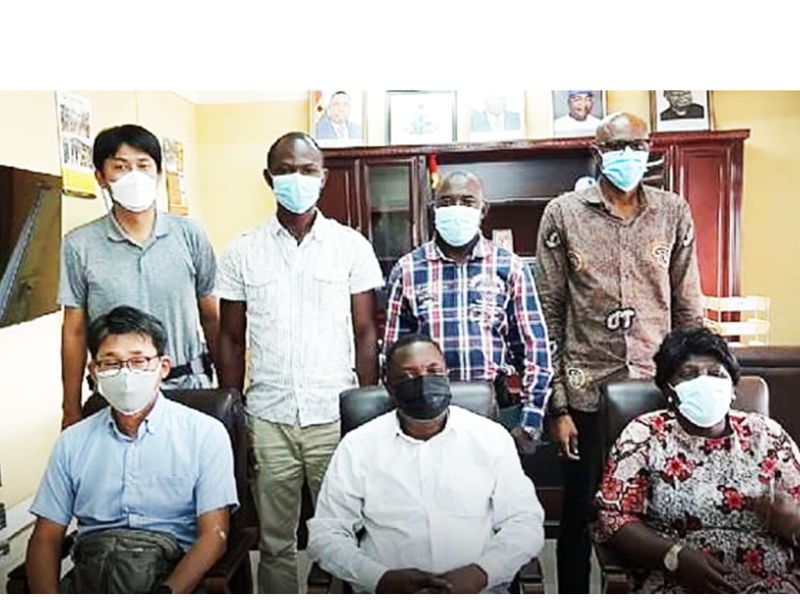The Japanese International Cooperation Agency (JICA) has expressed its interest in helping the Bono East region to become a major rice production hub in Ghana and the West Africa sub-region.
In this regard, it is collaborating with the Bono East Regional Co-ordinating Council to undertake feasibility studies and develop a roadmap towards the establishment of large-scale rice farms in various parts of the region.
A delegation from JICA has subsequently visited some communities in the region with rice valleys to engage the farmers and landowners to ascertain their readiness for the project.At a meeting with the Bono East Regional Minister, Kwasi Adu-Gyan, after its rounds in the communities, the delegation noted that the region is more than ready to ensure the smooth take-off of the project.
JICA, therefore, assured the regional minister of its preparedness to provide technical assistance towards the execution of the project.
Sharing some of its observations in the region with the regional minister, the delegation from JICA noted that the land in the region is “very rich for rice production” while the people in the area are ever ready to engage in large-scale rice farming.
JICA, however, noted that there was the need to enhance the technological and agronomical know-how of the farmers to boost their business.
The Regional Minister, Kwasi Adu-Gyan, on his part, was grateful to the delegation for their commitment to ensuring that the Bono East Rice Agenda becomes reality.
He encouraged them to come up with a comprehensive plan which could whet the appetite of the youth and many other people to venture into rice farming. He also touched on the need to supply the farmers with the right seedlings when the project kicks-off.
Already, the offices of the Iran and Saudi Arabian Embassies in Accra have also expressed their interest in the project.
President Akufo-Addo and the Minister of Food and Agriculture have also given their full endorsements to this course.
Rice is a major priority crop in West Africa. Nearly 16 million tons are consumed annually. The region wants to become independent of rice imports, but many farmers lack the right tools to achieve that goal.
In Ghana, rice is one of the major food staples consumed, but one in which the country is food insecure, with consumption outstripping domestic production and 66% of rice consumed being imported.
The economic costs of relying on imported rice are high and rising. Between 2007 and 2015 the amount spent on imported rice rose from $151m to $1.2bn, with domestic consumption supplemented by imports primarily from Thailand, Vietnam and India.
In 2017 Ghana produced 721,610 tonnes of rice but consumption, at 1.3m tonnes, far outstripped it and left a deficit of 580,300 tonnes.
According to figures from the Ministry of Food and Agriculture (MoFA), the rice deficit has been on an upward trend since 2011, from a deficit of 354,762 tonnes in 2011, rising to 503,875 tonnes in 2013, to a peak of 608,602 tonnes in 2015, before falling to 577,977 tonnes in 2016.
Domestic rice production grew from 44% of total consumption in 2016 to 47% of total consumption in 2017, modestly reducing the import burden.
The national rice deficit continued to grow even as the total domestic output of rice increased by 27% in the five-year period between 2013 and 2017, from 569,500 tonnes in 2013 to 721,610 tonnes in 2017.
IMPORTS
There is a cultural preference in Ghana for imported rice, as it is seen as being better quality. However, Owusu Afriyie Akoto, the minister of food and agriculture told local press in June 2018 that the reliance on imported rice was unsustainable and underscored the need to boost domestic rice production in order to meet the demand.
The government has put in place a series of measures to revolutionise the sector and ease imports of basic commodities – notably rice – and boost exports.
This focus on boosting production has already paid off, with 2017 rice output 4.9% higher than the 687,680 tonnes produced in 2016, the fourth consecutive annual increase in output.
Officials attribute the increase in production to the Planting for Food and Jobs (PFJ) programme and the development of irrigation schemes, and hope this is a shift to a dynamic where most of the rice consumed is locally produced.
BETTER INPUTS
In 2017 President Nana Akufo-Addo’s government launched its flagship agricultural policy, the PFJ, a four-year, GHS3.3bn ($713.1m) nationwide programme designed to improve the performance and size of Ghana’s agriculture sector, boost food security and create jobs. In June 2018 it was announced that some 3000 extension officers were to be employed to support the PFJ.
The programme, which focuses on cereals (including rice), legumes and vegetables, has five pillars: seed access and development, fertiliser access and systems development, agriculture extension services, market and e-agriculture.
Rice was selected for inclusion in the PFJ programme as it is an increasingly popular food and has a short gestation period, and thus can generate a meaningful return on investment for farmers in a relatively short period of time.
Under the seed pillar of the PFJ the government supplied 1699 tonnes of rice seed to farmers in 2017 at a price that was subsidised by 50%.
The rice seed distributed was 39% of the total seed stock distributed under the programme in 2017, with the other crops covered in the first year being maize and soybeans. The seed stock was of high quality and sourced from certified seed companies.
In addition to providing higher-quality seed at subsidised prices to farmers, the government also committed to strengthening the research and development of higher-yield strains of rice, with the objective of increasing yields in a sustainable and environmentally friendly way.
The PFJ programme aims to strengthen the seed production and distribution value chain to minimise leakages at different points in the system.
Under PFJ, farmers across the country received the fertiliser that they required at a subsidised cost and were provided with more consistent agricultural extension support services.
A key objective of the PFJ programme is to bring greater transparency to how fertiliser is distributed across the country.
To achieve this, the government worked with fertiliser distribution companies to ensure that all of the suppliers could get fertiliser to farmers across the country in a timely manner.
One of the factors that has previously driven fertiliser misuse and low yield rates was the late application of fertiliser or inadequate quantities.
These factors were alleviated under PFJ through the centralised and early facilitation efforts of the government.








